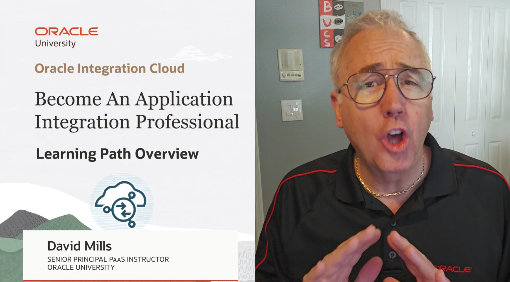We are excited to announce the availability of the new Become An Application Integration Professional (2025) Learning Path based on the OIC 3 environment. We have made several updates to the course with many new lessons and demos – now including more than 185 video recordings running for a total of over 20 hours. In addition, there are 11 hands-on labs comprising 62 practice exercises all designed to be executed in Oracle University’s on-demand lab environment for OIC 3.
Oracle Integration is an enterprise connectivity and automation platform for quickly modernizing applications, business processes, APIs, and data. Developers and business IT teams can connect any SaaS and on-premises applications six times faster with a visual development experience, embedded best practices, and prebuilt integrations for Salesforce, NetSuite, Workday, and many more. Users have native access to events and business objects in Oracle Cloud Fusion ERP, SCM, HCM, and CX to connect app-specific analytic silos and end-to-end processes such as requisition-to-receipt. The broad array of integrations, with prebuilt adapters and low-code customization, simplify migration to the cloud while streamlining hybrid and multicloud operations.
As a Leader in the Gartner® Magic Quadrant™ for Integration Platform as a Service (for 8 consecutive years), we believe Oracle can help you accelerate innovation and build trusted sources for AI-powered experiences with prebuilt connectivity and low-code automation.
Who is the Application Integration Learning Path designed for?
Since this learning path provides fundamental training for implementing integrations with Oracle Integration, obviously anyone interested in OIC is welcome. However, if you’re a software developer, integration specialist, cloud architect, or a system integrator – you certainly are in the target audience for this course. Ideally, any IT professional that has a basic understanding of integration fundamentals – and are responsible for integrating Cloud-to-Cloud applications or Cloud-to-On-Premises use cases – will benefit from this training. OCI Application Integration Professional certification provides you with a competitive edge in the industry and is one of the most sought-after certifications in OCI, with hundreds of thousands of learners already enrolled.
A sneak peek at the course…
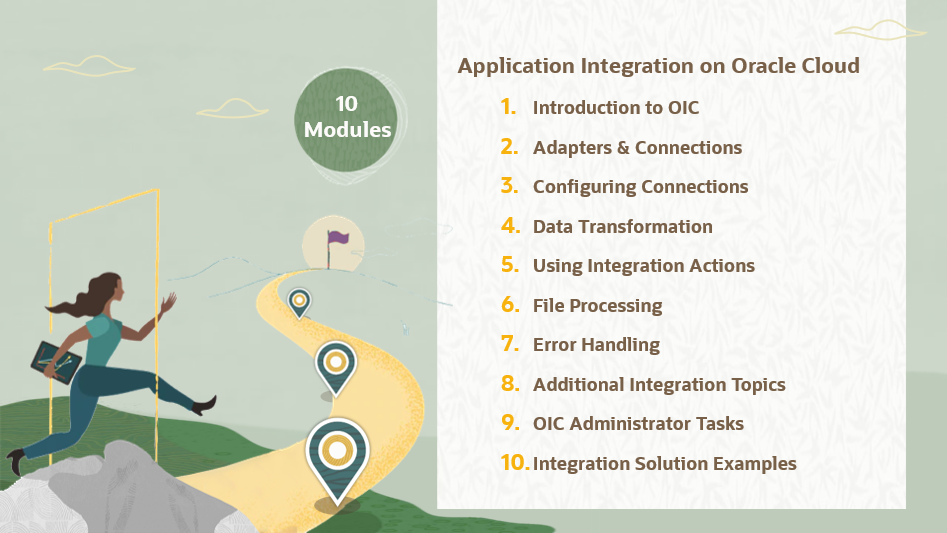
Module 1: Introduction to OIC – This module starts with a high-level look at OIC architecture and components, then proceeds to cover the basics of getting started with integration design and implementation. We also cover the new Projects feature that dramatically streamlines the organization of integration design and observability, as well as provides role-based access control (RBAC) for integration resources.
Module 2: Adapters & Connections – These lessons explore how to define connection resources leveraging one of the 80+ built-in OIC adapters. This module also teaches how to connect to applications or services located in private networks – either on-premises or in private cloud networks.
Module 3: Configuring Connections – As the title indicates, these lessons explain how to add a connection to an integration flow, and configure it based on two separate scenarios: a Trigger role connection, which serves as the entry point for an application pattern integration – and an Invoke role connection, which can be used at any point in any integration flow to access some external system or application. You’ll also see demos that highlight some configuration examples.
Module 4: Data Transformation – The lessons in this module focus primarily on using the Map Editor, which is accessed within a Map action. Along with the data mapper, it provides for adding XSLT functions and statements, as well as editing and testing the underlying XSLT code. Additionally, you’ll learn about the capabilities and usage of OIC Lookups.
Module 5: Using Integration Actions – With over 20 actions available to integration designers, this module starts with an overview lesson highlighting all actions. Then additional lessons teach you about the usage and configuration of many of those specific actions, facilitating the logic within your integration flows. Other actions (not covered here) are taught in later modules such as File Processing and Error Handling.
Module 6: File Processing – This module covers all the many aspects of receiving, processing, and sending files in integration flows – from defining FTP and File adapter connections – to configuring all the available connection operations. You’ll also learn about Stage file action operations, as well as how to transform native file formats. Additionally, to interact with the OIC embedded File Server, you’ll learn about the new File Server action.
Module 7: Error Handling – These lessons focus on why and how to design beyond the happy path in your integration implementations. You’ll learn about the OIC error hospital, implementing both global and scope-level fault handlers, as well as the usage of fault and end actions.
Module 8: Additional Integration Topics – As you might surmise from the title, instead of a primary focus area, the video lessons and demos in this module span a variety of topics as well as provide additional information on OIC capabilities and features mentioned only briefly in earlier modules. These include Schedule and Event pattern integrations, Observability features, more on Projects, integration lifecycle and versioning, and much more. There are also several videos that demonstrate the capabilities of the B2B feature in this module.
Module 9: OIC Administrator Tasks – The scope of these lessons involves tasks that must be done by someone assigned to the OIC Service Administrator role or (in some cases), those that have OCI Identity and Access (IAM) permissions to manage the OIC instance itself. This includes provisioning, assigning access roles to other OIC users, installing a Connectivity agent – to name just a few. This module is important for developers as well – since you’ll learn more about the issues associated with these tasks.
Module 10: Integration Solution Examples – In this module you’ll find a collection of videos that demonstrate use case solutions involving one or more OIC adapters to various external systems or applications. Our goal for these demos is to provide enough examples so that you can better understand how solutions can be built, as well as highlighting certain pre-built solutions that you can use out-of-the-box or customize as required.
And… Hands-on Labs!
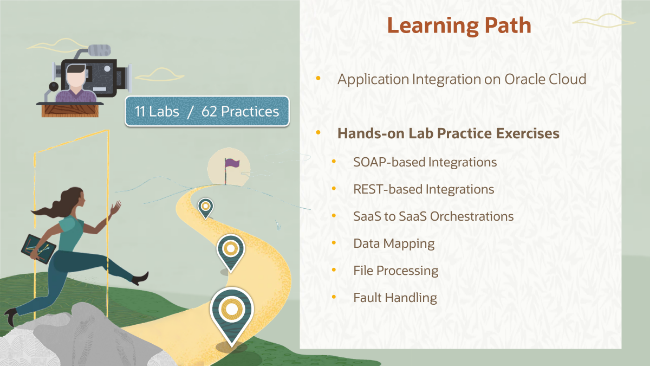
After you have completed the training modules, you should purchase an Oracle University Lab subscription (1-month lab access costs $29) so that you can do the hands-on practices that include everything from creating integrations from scratch, to cloning pre-built integrations that you can further customize. Each exercise provides a scenario overview and includes step-by-step instructions for completing each configuration task.
Additionally, we have recorded videos that provide a full end-to end demonstration of all the lab practices. These recordings are useful if you need help while executing the hands-on labs yourself. But others find these to be additionally informative as extra instruction is provided during the execution of the tasks. Of course, if you’re unable to purchase the lab environment – watching these videos is certainly the next best thing!
Earn the OCI Application Integration Professional Certification
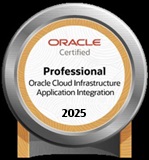
The learning path includes a professional-level certification exam, allowing learners to demonstrate their Oracle Integration knowledge. The exam assesses various competencies, including understanding OIC architecture and capabilities, defining and configuring connection resources, designing and implementing integration flows, as well as managing file processing and error handling use cases. The exam consists of 50 questions to be answered within 90 minutes, with a passing score of 68%.
To aid in preparation, the following resources are provided with this learning path:
- A separate Exam Preparation Training Course
- A full Practice Exam (containing 50 questions)
- Skill checks at the end of each course module
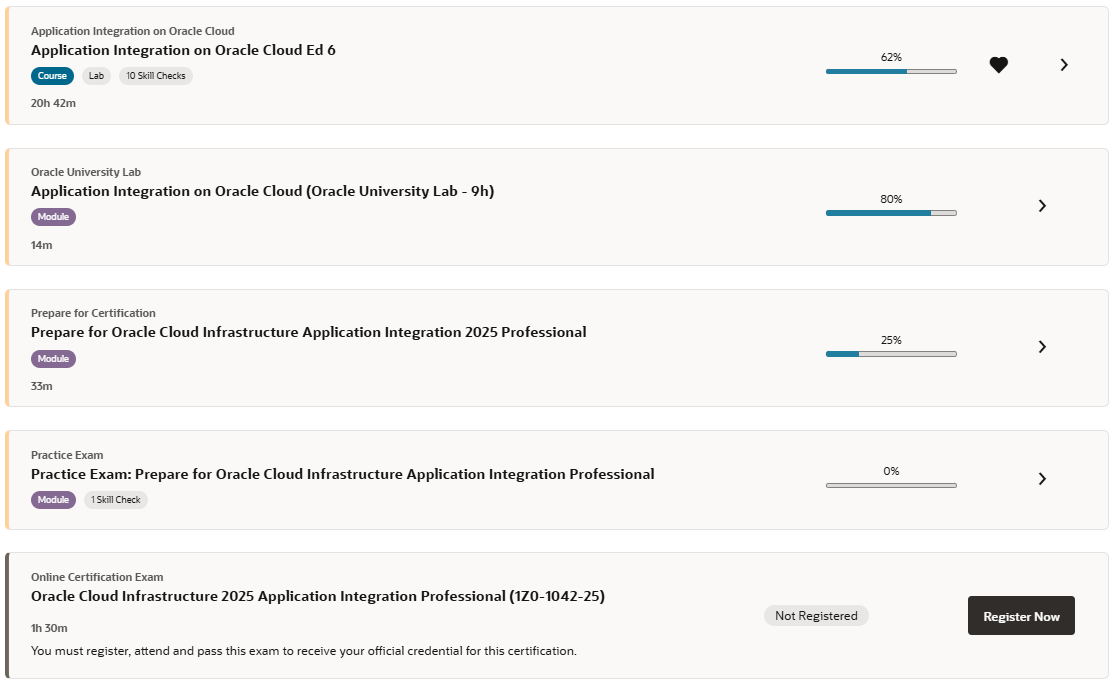
We sincerely hope you enjoy this updated learning path. Our Oracle University team is continuously building and delivering training, integrating feedback, and monitoring user data. If something is broken or not resonating with our users, we want to know. Please feel free to rate this course and leave a detailed review. Specific comments will help us understand what we’re doing well and what we can do differently.
Thanks for reading, and good luck with the course and the certification exam!
